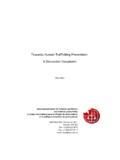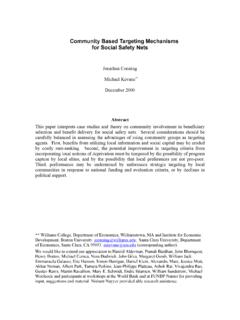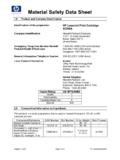Transcription of INTERNATIONAL REPORT CRIME PREVENTION AND …
1 CENTREINTERNATIONALPOUR LAPR VENTIONDE LA CRIMINALIT INTERNATIONALCENTREFOR THEPREVENTIONOF CRIMECENTROINTERNACIONALPARA LAPREVENCI NDE LA CRIMINALIDADINTERNATIONAL REPORT CRIME PREVENTION AND community safety : TRENDS AND PERSPECTIVES2010 INTERNATIONAL REPORT ON CRIME PREVENTION AND community safety :TRENDS AND PERSPECTIVES, 2010 Under the direction of Val rie Sagant and Margaret ShawPrepared by Manar Idriss, Manon Jendly, Jacqui Karn and Massimiliano MuloneWith the help and participation of the ICPC staff: Esthela Alvarado, Olivier Barchechat, Esteban Benavides, Kassa Bourne, Serges Bruneau, Laura Capobianco, Vivien Carli, Alexandra Dos Reis, St phanie Ferland, milie Gauduchon, Cvetanka Georgieva, M lissa Goupil-Landry, Joanie Prince, Yann-C dric Qu ro., Nathalie Rodrigues, Annik ICPC interns : Jeanne Allard, Viviana Arango, Mar a Teresa Brito, German D az Urrutia, Virginia Duarte Walsh, lise Fabing, Janina Grabs, Florence Hamel, Josu Koch, Sueann La Touche, Sarah MacLean, Luisa Paez, Diana Preciado, Matias Salazar, Katherine Saunders-Hastings, Zhen ZhaoThis publication was mainly funded by Public safety Canada and the D l gation interminist rielle la Ville of the government of France with support from the Ministry of Justice, France.
2 All ICPC members made contributions to the REPORT is available in English, French and Spanish on ICPC s the English version the translation was completed by Th r se Brown, Duncan Colin Campbell, Ramez Gowey ( Translation Services) and Sheila Wilkin; for the French version by Gladys Gazal Gowey ( Translation Services), Cindy Joyal, Susie Lamarche, Pierre St-Onge (Trans3W inc.) and Mayra Parra (edited by Georges Bastin); for the Spanish version by Lizette Flores and Jorge Parra (archiTEXTES with collaborators Mar a Isabel Llano, Teresa Santos et Arturo Parra).Graphic design:Danalco Impressions byInternational Centre for the PREVENTION of CRIME (ICPC)465, rue Saint-Jean, Suite 803 , Montreal, Quebec, Canada, H2Y 2R6 Telephone: 1 514 288-6731 Email: ISBN: 978-2-921916-69-1 Legal Deposit: April 2010 INTERNATIONAL REPORT 2010 / IOver the past several years, the ICPC has gathered together experts and practitioners in a number of fora and has built a global network of considerable significance.
3 In so doing, it has gained exposure to an impressive and widely varying array of CRIME PREVENTION strategies. Across the world, the striving for safe families, safe communities, safe societies and safe countries continues, in circumstances as different as the symptoms of unsafety that bedevil policy makers and ordinary citizens alike. The INTERNATIONAL REPORT provides a platform for learning and exchange, comparison and for the seeds of year three important themes are covered in the REPORT ; organized CRIME , trends in migration and drug and alcohol abuse. Sadly, these themes link many communities reflecting the links between oppression and poverty, depression and substance abuse. In documenting these themes, the REPORT shifts our thinking towards action in the mitigation of problems that extend beyond the daily experience of CRIME and violence and into issues of quality of life; the way in which individuals and communities are targeted by power hungry and greedy REPORT moves on to interrogate the governance of security.
4 Security is understood in different parts of the world to mean different things; for well resourced communities, security is often about the ability to protect against known risks, the application of technology and manpower against criminal intent. In this instance, security is used to encompass safety ; the PREVENTION , reduction or removal of these risks for an environment in which ordinary citizens live and move free of fear. This section applies a safety lens to working towards safe communities, understanding the mandates of the social sector, health, education, sports, arts and culture in terms of their potential contribution to safety and makes the link to training and capacity building, beyond the security ICPC has often led debate about evidence based or evidence led practices. In exploring the issues of evaluation, the REPORT guides practitioners to a better understanding of the need for evaluation and methodologies that work in this context, without restricting creativity and innovation essential to the development of new and better December 2009, ICPC celebrated it s Fifteenth Anniversary with an INTERNATIONAL colloquium that sparked with energy and crackled with new learning.
5 Despite the warmth of the reunion as old friends met and reconnected, there was also the constant challenge and hunger for newness and for better, faster, more cost effective, more inclusive, more sustainable practices. This REPORT too combines a sense of continuation and new information, new actors, new actions and Second INTERNATIONAL REPORT on CRIME PREVENTION and community safety has primarily been the work of a small team at the ICPC in Montreal, led with extraordinary energy and dedication by the out-going Director General, Val rie Sagant. Each member of the team deserves recognition for the work done, and I would like to express my pride in association with both the ICPC and the REPORT , as well as my gratitude and respect for those who have produced the REPORT . The editorial committee had the wonderful task of coming together to discuss and dissect, debate, prod and prompt as a part of the process. I hope they share the sense of a job well are sadly not close to solving the global problems of unsafety; yet with this REPORT we take another small collective step towards improving the quality of lives of many, in many communities, across our HoltmannMessage from the ICPC PresidentInternational REPORT 2010 / IIIThe INTERNATIONAL Centre for the PREVENTION of CRIME , a unique INTERNATIONAL forum and resource center dedicated to CRIME PREVENTION and community safety , was founded in 1994 to promote the exchange of ideas and knowledge on CRIME PREVENTION and community safety and share the knowledge between all PREVENTION members of the Centre include national and regional governments and cities, INTERNATIONAL organizations, non-government organizations, research centres and professional organizations all involved in PREVENTION , and brings together CRIME PREVENTION stakeholders from across the world.
6 It was founded in close partnership with the United Nations Human Settlements Programme (UN-HABITAT) and the United Nations Office on Drugs and CRIME (UNODC).The Centre has developed its activities around three principal axes. It acts as a centre of knowledge and information on CRIME PREVENTION developments and tools. It undertakes and publishes comparative analysis of strategies, practices and topics in PREVENTION , including this INTERNATIONAL REPORT , and compiles compendia of promising practices, and in its capacity as expert, it works with United Nations agencies to promote the integration of preventive approaches within INTERNATIONAL and government programmes and policy. Finally, it undertakes technical assistance to support the work of practitioners and policy makers on the ground, including through the dissemination of tools and educational resources, and exchanges between PREVENTION stakeholders. ICPCI nternational REPORT 2010 / VWe wish to thank in particular ICPC s Members who provided us with assistance in identifying promising practices and policies.
7 Our Editorial Advisory Committee composed of INTERNATIONAL experts and four members of the Executive Committee of ICPC, was expanded with an additional 9 members to increase the range of geographic, institutional and disciplinary backgrounds. We would like to thank very sincerely all the experts who provided us with advice and suggestions and for the time they devoted to this exercise: Marcelo Aebi, Kauko Aromaa, Elena Azaola, Alioune Badiane and the Safer Cities Team in UN-HABITAT, Claudio Beato, Gustavo Beliz, Jean-Paul Brodeur, Adam Crawford, Estela-Maris Deon, Benoit Dupont, Raymonde Dury, Ross Hastings, Barbara Holtmann, Peter Homel, Tim Hope, Erich Marks, Andrew Paterson, Azzedine Rakkah, Slawomir Redo, Dennis P. Rosenbaum, Benjamin R. Santa Maria, Michael Tonry, Elrena Van Der Spuy, Jennifer Wood and Anne Wyvekens. Twelve members of the Committee were able to participate in the Editorial Committee meeting held in Montreal, in June 25-26 2009.
8 Their comments have considerably enriched the REPORT , and their encouragement and support was a great source of motivation and inspiration. We would also like to thank the 17 authors of external expert contributions in this second REPORT , who have shed a multidisciplinary light on certain discussion topics: Martin Appiolaza , Elena Azaola , Julie Berg, Bill Dixon, Kate Freiberg, S verine Germain, Peter Homel, Ross Homel, Barbara Hudson, Guillaume Landry, Eric Lenoir, Kalyani Menon-Sen , Carlo Morselli, Marc Parent, Brian Payne, Michael Rowe, Samuel Tanner and Elrena Van Der practitioners, researchers, and decision-makers also provided valuable input to this REPORT through their advice, ideas, research, and suggestions for improvement. We cannot name all of them individually, but we wish to extend to them our heartfelt thanks for their availability, time and support. Acknowledgements INTERNATIONAL REPORT 2010 / VIIThe INTERNATIONAL Centre for the PREVENTION of CRIME was created in 1994 to promote INTERNATIONAL exchange in the field of CRIME PREVENTION .
9 One of its goals is to REPORT , every two years, on the evolution of PREVENTION and community safety around the world: the evolution and outcomes of public policies, strategies and practice. This 2010 INTERNATIONAL REPORT is the second edition in this the basis of this analysis, two key findings emerge: In 2010, CRIME PREVENTION policies are no longer limited to reducing rates of CRIME , but also aim to improve the quality of com-munity life and our ability to live together; Although there has been considerable progress in the development of PREVENTION policies, they are still marginalized within the broader scope of public safety our analyses is based on broad INTERNATIONAL comparisons, it should be recognized that CRIME is very unevenly distributed throughout the world. Certain countries, such as Guatemala, have homicide rates which are higher than 30 per 100,000 population, whereas in many other countries, such as those in Western Europe or Southeast Asia, homicide rates are more than 10 times lower.
10 Important disparities are also observed between and within regions: Africa, Egypt, Morocco, or Mauritius have homicide rates lower than 3 per 100,000 population, far lower than those in South Africa. Within the same country, discrepancies can be significant: for example in Colombia, the city of Tunja (population 150,000) has a rate of 7 homicides compared with 128 in the city of San Jos del Guaviare (population 50,000). Finally, within the same city, homicide rates can vary significantly from one neighbourhood to another. In neighbourhoods of Rio de Janeiro, for example, rates vary from 2 to 12 homicides per 100,000 In 2010, public policies in PREVENTION go beyond reducing CRIME but also aim to improve the quality of community life. Approaches to CRIME PREVENTION has developed over time and are reflected in different United Nations resolutions and in practices and policies implemented around the world.









